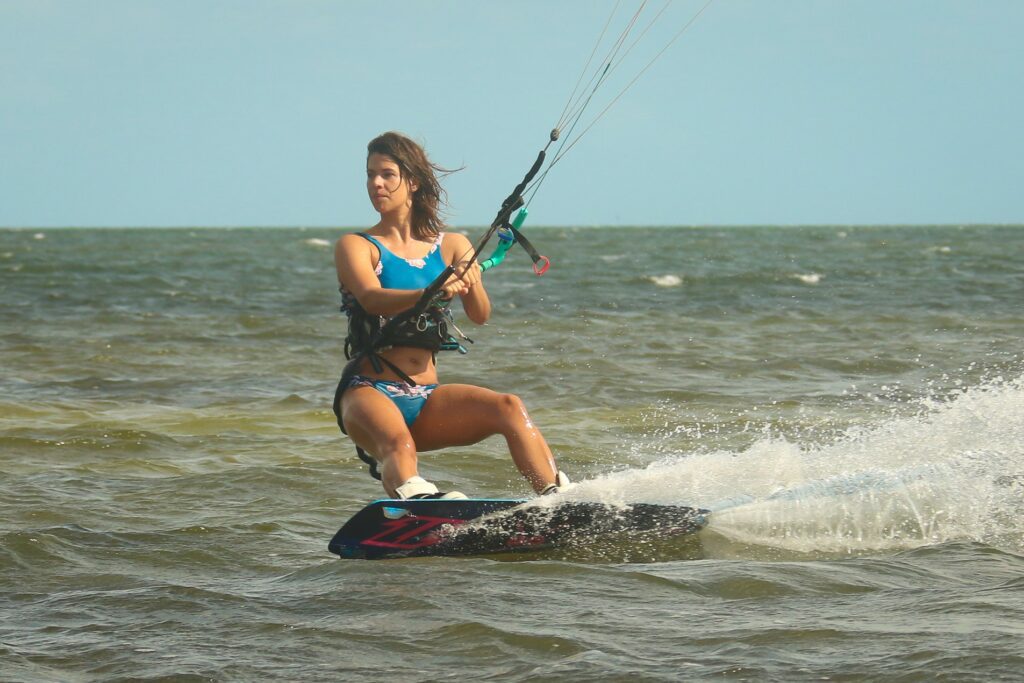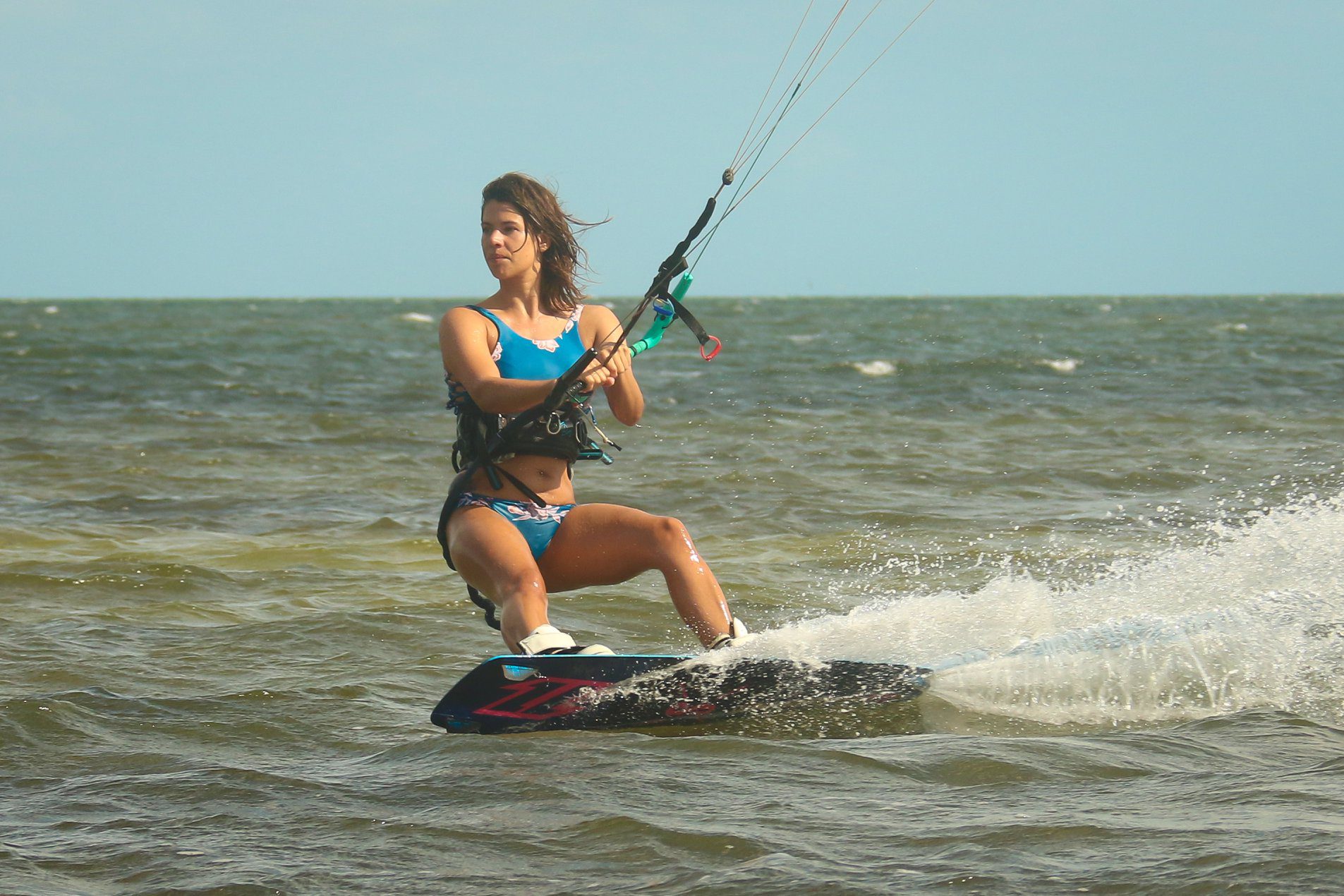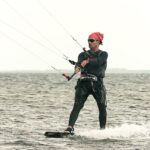
Kitesurfing vs. Kiteboarding.
Kitesurfing and Kiteboarding are two popular water sports that have become increasingly popular recently. Both sports involve using a kite to propel a rider across the water, but there are some critical differences between the two.
Overview of Kitesurfing and Kiteboarding.
This article will explore the differences between kitesurfing and Kiteboarding, including the equipment used, the techniques employed, and the conditions best suited for each sport. By the end, you’ll better understand which sport is right for you.
Kitesurfing and Kiteboarding are popular extreme sports that use a kite to propel a person across the water. Both sports involve using a large kite to generate power and lift, allowing the rider to move across the water and perform tricks and stunts.
Kitesurfing is a water sport that involves using a kite to propel a rider across the water while standing on a board. The kite is attached to the rider by a harness to generate power and lift, allowing the rider to move across the water and perform tricks and stunts. Kitesurfing is an adrenaline-filled sport that requires skill and practice to master.
Kiteboarding is similar to kitesurfing, but the rider is strapped into a board like a wakeboard or a snowboard. The kite generates power and lift, allowing the rider to move across the water and perform tricks and stunts. Kiteboarding is a more extreme sport than kitesurfing and requires more excellent skill and experience to master.
Kitesurfing and Kiteboarding are popular extreme sports offering a thrilling and adrenaline-filled experience. Both sports require skill and practice to master, and people of all ages and skill levels can enjoy them. Kitesurfing and Kiteboarding are both exciting and challenging sports that can provide a lifetime of fun and adventure.
Kitesurfing vs. Kiteboarding: Equipment Differences.
Kitesurfing and Kiteboarding are two prevalent and exciting water sports that have been around for decades.
While they both involve using a kite to propel the rider across the water, the two sports have some key differences. One of the main differences between kitesurfing and Kiteboarding is the equipment used.
Kitesurfing is a sport that requires a large, inflatable kite, usually between 9 and 18 square meters in size. The kite is attached to the rider via a harness and a bar that the rider holds onto. The kite pulls the rider across the water and generates a lift. Kitesurfing also requires a board, usually between 4 and 6 feet long and designed to provide stability and control.
On the other hand, Kiteboarding requires a smaller, more rigid kite, usually between 4 and 8 square meters. The kite is attached to the rider via a harness and a bar that the rider holds onto. The kite pulls the rider across the water and generates a lift. Kiteboarding also requires a board, usually between 4 and 6 feet long and designed to provide stability and control.
Kitesurfing and Kiteboarding also require different types of safety equipment. Kitesurfing involves using a helmet, a life jacket, and a leash that attaches the rider to the kite. Kiteboarding requires a helmet, a life jacket, and a wetsuit.
In conclusion, kitesurfing and Kiteboarding are two exciting water sports requiring different equipment types. Kitesurfing requires a large, inflatable kite, a board, a helmet, a life jacket, and a leash. Kiteboarding requires a smaller, more rigid kite, a board, a helmet, a life jacket, and a wetsuit. Both sports are thrilling and provide an adrenaline rush, but the equipment is different.
Kitesurfing vs. Kiteboarding: Riding Styles.
Kitesurfing and Kiteboarding are two distinct water sports that have become increasingly popular recently. While they share many similarities, there are also some critical differences between the two sports.
Understanding the riding styles of each can help you decide which is right for you.
Kitesurfing is a sport that combines elements of surfing, wakeboarding, and paragliding. The rider uses a large kite to propel themselves across the water while standing on a board. Kitesurfing is a fast-paced, thrilling sport that allows riders to reach up to 40 mph speeds. It is also a great way to explore new places, as the kite can be used to travel upwind.
Kiteboarding is a sport that is similar to wakeboarding but with the addition of a kite. The rider stands on a board and propels the kite across the water. Kiteboarding is a great way to get an adrenaline rush, as riders can reach up to 30 mph speeds. It is also a great way to explore new places, as the kite can be used to travel upwind.
Both kitesurfing and Kiteboarding are thrilling sports that offer riders the chance to explore new places and get an adrenaline rush. However, there are some critical differences between the two. Kitesurfing is faster and more dynamic, while Kiteboarding is more technical and requires more skill. Kitesurfing is also more physically demanding, as the rider needs to be able to maneuver the kite while standing on the board. Kiteboarding is more accessible to beginners, as it requires less physical strength and coordination.
Ultimately, the choice between kitesurfing and Kiteboarding comes down to personal preference. Both sports offer riders the chance to explore new places and get an adrenaline rush, but the riding styles are different. Understanding the differences between the two can help you decide which one is right for you.
Kitesurfing vs. Kiteboarding: Safety Considerations.
Kitesurfing accessories.
Regarding kitesurfing accessories, there are a few must-haves for any beginner. The first and most important piece of equipment is a TWIN TIPS board.
A twin tip board is a board with two points, which allows for more control when maneuvering. You’ll also need to purchase a kitesurfing harness designed to keep you connected to your board while kiting. Investing in a quality kite foil is also essential as it will provide additional lift and keep you stable.
Kitesurfing and Kiteboarding are popular extreme sports that use a kite to propel the rider across the water. Both sports involve many risks and require great skill and knowledge to participate safely. While both sports are thrilling and can be enjoyed by all ages, there are significant safety considerations to remember when participating in either activity.
Kitesurfing and Kiteboarding both involve using a kite, which is attached to the rider by a harness. The kite is then used to pull the rider across the water, allowing them to reach up to 50 miles per hour. While this can be an exhilarating experience, it also comes with a certain degree of risk.
The weather is the most critical safety consideration when participating in kitesurfing or Kiteboarding. Strong winds can make the kite challenging to control and even cause it to become unstable and crash. Before participating in either sport, it is essential to check the weather conditions and ensure the wind is not too strong.
In addition to the weather, ensuring that the kite is appropriately set up and that the rider is wearing the appropriate safety gear is essential. A helmet, life jacket, and impact vest are all crucial safety equipment that should be worn at all times. It is also necessary to be aware of other people in the area, as collisions can occur if riders need to pay attention.
Finally, it is essential to have a basic understanding of the sport before attempting either kitesurfing or Kiteboarding. It is necessary to take lessons from a qualified instructor and to practice in safe, open areas until the rider is comfortable and confident in their abilities.
Kitesurfing and Kiteboarding can be exciting and rewarding experiences, but it is essential always to keep safety in mind. Riders can enjoy these sports safely and responsibly by checking the weather, ensuring the kite is appropriately set up, and wearing the appropriate safety gear.
Kitesurfing vs. Kiteboarding: Popularity and Locations.
Kitesurfing and Kiteboarding are two popular water sports that have been around for decades. Both sports involve using a kite to propel a rider across the water. While the two marks may appear similar, they have some distinct differences.
Kitesurfing is the more popular of the two sports. I use a kite to pull the rider across the water while standing on a surfboard. Kitesurfing is prevalent in many parts of the world, including Europe, North America, South America, and Australia. It is also popular in tropical locations like Hawaii and the Caribbean.
Kiteboarding is a more extreme version of kitesurfing. It involves using a kite to pull the rider across the water while standing on a board similar to a wakeboard. Kiteboarding is prevalent in many parts of the world, including Europe, North America, South America, and Australia. It is also popular in tropical locations like Hawaii and the Caribbean.
Both kitesurfing and Kiteboarding can be enjoyed in a variety of locations. Kitesurfing is often done in open ocean areas, while Kiteboarding is often done in shallow, flat water areas. Both sports can be enjoyed in places with strong winds, such as coastal areas and near lakes.
Kitesurfing and Kiteboarding are popular water sports that offer an exciting and thrilling experience. Both sports involve using a kite to propel the rider across the water. Kitesurfing is the more popular of the two sports, while Kiteboarding is more extreme. Both sports can be enjoyed in various locations, including open ocean areas, shallow, flat water areas, and areas with strong winds.
In conclusion, kitesurfing and Kiteboarding are two distinct sports that share some similarities. Kitesurfing focuses more on wave riding and freestyle tricks, while Kiteboarding focuses more on freeriding and big air. Both sports require skill and experience to master, and each has its unique style and set of challenges. Ultimately, the choice between kitesurfing and Kiteboarding is up to the individual, and both can be enjoyed in various settings.
Excerpt.
Kitesurfing and Kiteboarding are similar water sports involving a kite aboard. While they share many similarities, they also have distinct differences. Kitesurfing focuses more on tricks and jumps, while Kiteboarding focuses more on speed and racing.
Author
Latest entries
 WatersportsMay 10, 2023Qatar GKA Freestyle Kite World Cup, Fuwairit Kite Beach, Qatar: 31 January – 04 February – 2023
WatersportsMay 10, 2023Qatar GKA Freestyle Kite World Cup, Fuwairit Kite Beach, Qatar: 31 January – 04 February – 2023 WatersportsMarch 30, 2023Seven Navigation Tips That All Kite Surfers Should Know.
WatersportsMarch 30, 2023Seven Navigation Tips That All Kite Surfers Should Know. WatersportsMarch 30, 2023Why Safety First is the Most Important Aspect of Kitesurfing.
WatersportsMarch 30, 2023Why Safety First is the Most Important Aspect of Kitesurfing. WatersportsMarch 30, 2023Tips to Improve Your Body Drag Skills in Kitesurfing.
WatersportsMarch 30, 2023Tips to Improve Your Body Drag Skills in Kitesurfing.




